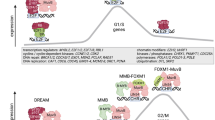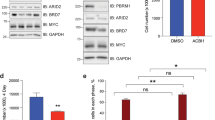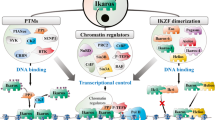Abstract
JHDM1B is an evolutionarily conserved and ubiquitously expressed member of the JHDM (JmjC-domain-containing histone demethylase) family1,2,3. Because it contains an F-box motif, this protein is also known as FBXL10 (ref. 4). With the use of a genome-wide RNAi screen, the JHDM1B worm orthologue (T26A5.5) was identified as a gene that regulates growth5. In the mouse, four independent screens have identified JHDM1B as a putative tumour suppressor by retroviral insertion analysis6,7,8,9. Here we identify human JHDM1B as a nucleolar protein and show that JHDM1B preferentially binds the transcribed region of ribosomal DNA to repress the transcription of ribosomal RNA genes. We also show that repression of ribosomal RNA genes by JHDM1B is dependent on its JmjC domain, which is necessary for the specific demethylation of trimethylated lysine 4 on histone H3 in the nucleolus. In agreement with the notion that ribosomal RNA synthesis and cell growth are coupled processes, we show a JmjC-domain-dependent negative effect of JHDM1B on cell size and cell proliferation. Because aberrant ribosome biogenesis and the disruption of epigenetic control mechanisms contribute to cellular transformation, these results, together with the low levels of JHDM1B expression found in aggressive brain tumours, suggest a role for JHDM1B in cancer development.
This is a preview of subscription content, access via your institution
Access options
Subscribe to this journal
Receive 51 print issues and online access
$199.00 per year
only $3.90 per issue
Buy this article
- Purchase on Springer Link
- Instant access to full article PDF
Prices may be subject to local taxes which are calculated during checkout




Similar content being viewed by others
References
Tsukada, Y. et al. Histone demethylation by a family of JmjC domain-containing proteins. Nature 439, 811–816 (2006)
Klose, R. J., Kallin, E. M. & Zhang, Y. JmjC-domain-containing proteins and histone demethylation. Nature Rev. Genet. 7, 715–727 (2006)
Shi, Y. & Whetstine, J. R. Dynamic regulation of histone lysine methylation by demethylases. Mol. Cell 25, 1–14 (2007)
Jin, J. et al. Systematic analysis and nomenclature of mammalian F-box proteins. Genes Dev. 18, 2573–2580 (2004)
Pothof, J. et al. Identification of genes that protect the C. elegans genome against mutations by genome-wide RNAi. Genes Dev. 17, 443–448 (2003)
Li, J. et al. Leukaemia disease genes: large-scale cloning and pathway predictions. Nature Genet. 23, 348–353 (1999)
Suzuki, T. et al. New genes involved in cancer identified by retroviral tagging. Nature Genet. 32, 166–174 (2002)
Suzuki, T., Minehata, K., Akagi, K., Jenkins, N. A. & Copeland, N. G. Tumor suppressor gene identification using retroviral insertional mutagenesis in Blm-deficient mice. EMBO J. 25, 3422–3431 (2006)
Hwang, H. C. et al. Identification of oncogenes collaborating with p27Kip1 loss by insertional mutagenesis and high-throughput insertion site analysis. Proc. Natl Acad. Sci. USA 99, 11293–11298 (2002)
Dousset, T. et al. Initiation of nucleolar assembly is independent of RNA polymerase I transcription. Mol. Biol. Cell 11, 2705–2717 (2000)
Daniely, Y., Dimitrova, D. D. & Borowiec, J. A. Stress-dependent nucleolin mobilization mediated by p53–nucleolin complex formation. Mol. Cell. Biol. 22, 6014–6022 (2002)
Grandori, C. et al. c-Myc binds to human ribosomal DNA and stimulates transcription of rRNA genes by RNA polymerase I. Nature Cell Biol. 7, 311–318 (2005)
Voo, K. S., Carlone, D. L., Jacobsen, B. M., Flodin, A. & Skalnik, D. G. Cloning of a mammalian transcriptional activator that binds unmethylated CpG motifs and shares a CXXC domain with DNA methyltransferase, human trithorax, and methyl-CpG binding domain protein 1. Mol. Cell. Biol. 20, 2108–2121 (2000)
Koyama-Nasu, R., David, G. & Tanese, N. The F-box protein Fbl10 is a novel transcriptional repressor of c-Jun. Nature Cell Biol. 9, 1074–1080 (2007)
Brock, G. J. & Bird, A. Mosaic methylation of the repeat unit of the human ribosomal RNA genes. Hum. Mol. Genet. 6, 451–456 (1997)
Earley, K. et al. Erasure of histone acetylation by Arabidopsis HDA6 mediates large-scale gene silencing in nucleolar dominance. Genes Dev. 20, 1283–1293 (2006)
Preuss, S. & Pikaard, C. S. rRNA gene silencing and nucleolar dominance: Insights into a chromosome-scale epigenetic on/off switch. Biochim. Biophys. Acta. 1769, 383–392 (2007)
Ruggero, D. & Pandolfi, P. P. Does the ribosome translate cancer? Nature Rev. Cancer 3, 179–192 (2003)
Zhao, J., Yuan, X., Frodin, M. & Grummt, I. ERK-dependent phosphorylation of the transcription initiation factor TIF-IA is required for RNA polymerase I transcription and cell growth. Mol. Cell 11, 405–413 (2003)
Bukhari, M. H., Hashmi, I., Naeem, S., Abro, A. K. & Chaudhry, N. A. Use of AgNOR index in grading and differential diagnosis of astrocytic lesions of brain. Pak. J. Med. Sci. 23, 206–210 (2007)
Bredel, M. et al. Functional network analysis reveals extended gliomagenesis pathway maps and three novel MYC-interacting genes in human gliomas. Cancer Res. 65, 8679–8689 (2005)
Freije, W. A. et al. Gene expression profiling of gliomas strongly predicts survival. Cancer Res. 64, 6503–6510 (2004)
Busino, L. et al. SCFFbxl3 controls the oscillation of the circadian clock by directing the degradation of cryptochrome proteins. Science 316, 900–904 (2007)
Dorrello, N. V. et al. S6K1- and βTRCP-mediated degradation of PDCD4 promotes protein translation and cell growth. Science 314, 467–471 (2006)
Amador, V., Ge, S., Santamaria, P. G., Guardavaccaro, D. & Pagano, M. APC/CCdc20 controls the ubiquitin-mediated degradation of p21 in prometaphase. Mol. Cell 27, 462–473 (2007)
Groisman, R. et al. The ubiquitin ligase activity in the DDB2 and CSA complexes is differentially regulated by the COP9 signalosome in response to DNA damage. Cell 113, 357–367 (2003)
Bashir, T., Dorrello, N. V., Amador, V., Guardavaccaro, D. & Pagano, M. Control of the SCFSkp2-Cks1 ubiquitin ligase by the APC/CCdh1 ubiquitin ligase. Nature 428, 190–193 (2004)
Leung, A. K. et al. Quantitative kinetic analysis of nucleolar breakdown and reassembly during mitosis in live human cells. J. Cell Biol. 166, 787–800 (2004)
Arabi, A. et al. c-Myc associates with ribosomal DNA and activates RNA polymerase I transcription. Nature Cell Biol. 7, 303–310 (2005)
Cloos, P. A. et al. The putative oncogene GASC1 demethylates tri- and dimethylated lysine 9 on histone H3. Nature 442, 307–311 (2006)
Frescas, D., Mavrakis, M., Lorenz, H., Delotto, R. & Lippincott-Schwartz, J. The secretory membrane system in the Drosophila syncytial blastoderm embryo exists as functionally compartmentalized units around individual nuclei. J. Cell Biol. 173, 219–230 (2006)
Acknowledgements
We thank D. Reinberg, R. Santoro, J. Skaar and J. Wysocka for suggestions and/or critically reading the manuscript; L. Busino for helping with qRT–PCR analysis; and J. Wysocka and G. David for reagents. D.F. is grateful to A. Nans. M.P. is grateful to T. M. Thor for continuous support. This work was supported by an Emerald Foundation grant to D.G., a Fellowship from the American-Italian Cancer Foundation to D.G., a fellowship from the German Research Foundation to F.B., a Bernard B. Levine Foundation award to R.K.-N., and grants from the NIH to M.P.
Author Contributions D.F. performed all experiments, contributed to their planning and co-wrote the manuscript. D.G. contributed to the planning of experiments and discussing and interpreting results. F.B. conducted the fluorescence-activated cell sorting analysis. R.K.-N. generated JHDM1B mutants. M.P. coordinated the study and co-wrote the manuscript. All authors discussed the results and commented on the manuscript.
Author information
Authors and Affiliations
Corresponding author
Ethics declarations
Competing interests
The authors declare no competing financial interests.
Supplementary information
Supplementary Figures
The file contains Supplementary Figures S1-S16 with Legends. (PDF 1590 kb)
Rights and permissions
About this article
Cite this article
Frescas, D., Guardavaccaro, D., Bassermann, F. et al. JHDM1B/FBXL10 is a nucleolar protein that represses transcription of ribosomal RNA genes. Nature 450, 309–313 (2007). https://doi.org/10.1038/nature06255
Received:
Accepted:
Issue Date:
DOI: https://doi.org/10.1038/nature06255
This article is cited by
-
The emerging roles of histone demethylases in cancers
Cancer and Metastasis Reviews (2024)
-
Genome-wide screens uncover KDM2B as a modifier of protein binding to heparan sulfate
Nature Chemical Biology (2021)
-
FBXL10 promotes EMT and metastasis of breast cancer cells via regulating the acetylation and transcriptional activity of SNAI1
Cell Death Discovery (2021)
-
Unraveling the epigenetic landscape of glomerular cells in kidney disease
Journal of Molecular Medicine (2021)
-
Identification of Structural Elements of the Lysine Specific Demethylase 2B CxxC Domain Associated with Replicative Senescence Bypass in Primary Mouse Cells
The Protein Journal (2020)
Comments
By submitting a comment you agree to abide by our Terms and Community Guidelines. If you find something abusive or that does not comply with our terms or guidelines please flag it as inappropriate.



